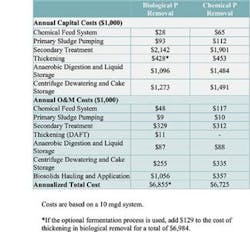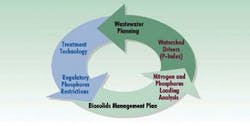Changing Rules Call for Improved Biosolids Phosphorus Management
By Michael R. Murray, David L. Clark and Greg Moen
With growing concerns regarding the impacts of phosphorus-rich biosolids on land applications, a renewed focus on phosphorus chemistry and how various treatment technologies can be used to reduce these impacts has emerged.
Currently, land application of biosolids is based on agronomic rates of nitrogen and risk-based loading rate limits of several trace elements. Phosphorus concentrations in biosolids are such that agronomic application rates based on nitrogen loadings will often result in an oversupply of phosphorus to the soil.
A buildup of phosphorus in soils may result in a greater probability of phosphorus losses via runoff, leaching and erosion. This potential problem is further exacerbated by regulatory demand for removing greater quantities of phosphorus from wastewater prior to discharge to surface waters, which will result in even higher concentrations of phosphorus in biosolids.
Some states – including Maryland, Oklahoma, Pennsylvania and Florida – have begun to regulate biosolids application rates based on agronomic rates of phosphorus and nitrogen; other states, such as Texas, are anticipated to follow suit. Many municipalities anticipate that phosphorus-based management programs will restrict the agricultural use of biosolids by establishing upper limits for soil test phosphorus or similar criteria, above which land application is limited or prohibited. The implications could result in the need for additional land or changes in biosolids use.
A review of several regulatory programs shows that phosphorus management considers phosphorus mobility in part of the topsoil only and neglects the fate of mobilized phosphorus along its entire flow path.
Assessing the Risk
To characterize the risk of biosolids land application on water quality, the chemical properties of the biosolids must be understood. Furthermore, risk measurements should be site specific and not rely solely on a single measurement of phosphorus, such as an agronomic soil test phosphorus value.
Areas with intense agricultural production, shallow groundwater, and coarse-textured soils with little phosphorus sorbing capacity represent the greatest challenge for phosphorus management.
Areas with high phosphorus sorbing capacity, a great depth to groundwater, and a significant distance to surface water represent minimal risk.
The Phosphorus Index (P-Index), a concept developed by the Natural Resource Conservation Service (NRCS), has been implemented in a number of states as an approach toward agricultural phosphorus management. The P-Index incorporates several factors, including soil erosion, runoff class and soil phosphorus tests, as well as phosphorus source properties, application rates and methods.
This P-Index was developed with a focus on livestock manures and is not directly applicable to biosolids land application sites. However, many of the concepts – such as the risk-based approach – are applicable and the P-Index could serve as a starting point for developing a comprehensive, risk-based approach for phosphorus management at biosolids land application sites.
The makeup of biosolids greatly influences the bioavailability of phosphorus in biosolids. The Phosphorus Saturation Index (PSI) – defined as the phosphorus divided by aluminum plus iron mole ratio (measured as total phosphorus, iron and aluminum, or as oxalate extractable) – is a good measurement for predicting the relative bioavailability of phosphorus in biosolids. Furthermore, industry standards and literature data hold that a ratio value of less than one results in a low bioavailable (less mobile) phosphorus form in soils. Currently, the P-Index does not account for biosolids properties and the ability of biosolids to reduce phosphorus bioavailability, compared to fertilizers and manures.
Determining Ideal Phosphorus Removal Mechanisms
Many wastewater treatment facilities are faced with the task of reducing phosphorus in their effluent discharges to surface water, which in turn will result in increased phosphorus concentrations in biosolids. Thus, planning considerations must account for restrictions at the land application sites as well as the bioavailability and concentration of phosphorus in the biosolids.
Wastewater treatment technology for Enhanced Biological Phosphorus Removal (EBPR) and chemical precipitation of phosphorus are both well understood and broadly applied. Design criteria are well established and removal performance is predictable for both methods. EBPR is an elegant approach to concentrating phosphorus in the biomass of the liquid stream treatment process and has the advantages of minimal increases in solids quantities for phosphorus removal without purchased chemicals. However, phosphorus bioavailability is greater than with chemically precipitated solids.
Chemical precipitation has the advantage of reducing the bioavailability of phosphorus in the biosolids by decreasing the PSI. The disadvantages are that chemicals must be purchased and larger quantities of solids are generated. Combinations of chemical precipitation of phosphorus and EBPR may provide opportunities for production of biosolids that match the PSI with land application site requirements.
For land application sites where there is minimal phosphorus risk (low-risk sites), biosolids phosphorus is not a significant driver in assessing which phosphorus removal treatment technologies to use.
For medium-risk sites, biosolids phosphorus is also not a significant driver; however, it is recommended that contingencies be incorporated into the design to allow for adjustments to the PSI if soil sampling at the land application site reveals an increase in available phosphorus.
For high-risk sites, biosolids phosphorus becomes a major driver in facility planning. Under this scenario, planning should evaluate phosphorus removal technologies relating to the bioavailability of phosphorus, the concentration of phosphorus, and the capital and O&M costs for additional lands.
To illustrate the interdependency of wastewater treatment plant operations and biosolids management, an economic analysis was performed for a hypothetical treatment plant under the high-risk scenario to evaluate wastewater treatment plant phosphorus removal mechanisms with respect to the risk of phosphorus mobility to water at the biosolids land application site.
In some cases (high and very high P-Index ratings), it may be cost effective to remove phosphorus by chemical precipitation as opposed to EBPR, from a comprehensive system-wide standpoint. System costs for a chemical phosphorus removal plant can be lower than for a biological phosphorus removal plant, mainly due to the increased costs associated with biosolids hauling and application. Alternatively, a hybrid of chemical and biological phosphorus removal processes can be used to optimize the total system cost of both treatment and biosolids disposal.
Conclusion
Phosphorus loading rates will be an important issue for wastewater utilities in the near future, as regulators are focusing their attention on the detrimental environmental effects of over application of phosphorus to the land. Currently, states and EPA regions are regulating biosolids phosphorus application differently, with varying impacts on biosolids management programs.
Depending on a state's approach to regulating biosolids phosphorus application, the choice of technology employed for phosphorus removal from the liquid stream has implications for a wastewater utility's biosolids management program. Biosolids managers and treatment plant staff need to begin a dialogue on this issue to understand the implications of the new restrictions on their particular programs. The overall costs and impacts associated with a wastewater utility's operations – including treatment and biosolids management – should be considered before a phosphorus removal technology is chosen. In some cases, restrictions on biosolids phosphorus application can dramatically change the economic comparison of phosphorus removal technologies at a wastewater treatment plant. This further underscores the importance of a comprehensive systems approach in biosolids phosphorus management and wastewater facility planning efforts.
This article was adapted from an article that originally appeared in Waterscapes, a technical publication of HDR. Dr. Michael Murray, Ph.D., and David Clark, PE, can be reached in HDR's Boise, ID, office at 208-342-3779 or email [email protected] or [email protected]. Greg Moen, E.I.T., can be reached in HDR's Seattle office at 425-450-6222, or email [email protected].



